|
In Illinois, there are 9 common root rot and stem diseases that
attack soybeans, causing varying degrees of damage from year to
year. Each has characteristic symptoms that should make it possible
to identify the trouble readily. All of the symptoms cause affected
plants to wilt and turn brown, and usually to die prematurely. All
are caused by common soilborne fungi.
PHYTOPHTHORA ROT
Symptoms
Phytophthora root and stem rot, caused by the soilborne fungus
Phytophthora sojae (synonyms P. megasperma f. sp.
glycinea and P.m. var. sojae) may attack plants
at any stage of growth. The disease, which is favored by cool and
rainy weather, may kill the seedlings before emergence; or they
may shrivel and die after emergence, leaving gaps in the rows. Older
plants may develop dull dark brown lesions extending upward on the
stem from the soil line, occasionally to the tenth node. The taproot
becomes dark brown, and the entire root system may be rotted. Infected
plants usually turn yellow, wilt, and die. The withered leaves commonly
remain attached to dead plants for a week or more. Phytophthora
is found most often in heavy clay soils that are poorly drained
and compacted, especially in low areas where surface water has been
standing for several days. This disease is also favored by reduced
tillage and early planting. Plants are often killed in sections
of the rows (Figure 1). Plant losses and yield reductions may approach
100 percent in very susceptible soybean cultivars. The severity
of loss depends on cultivar susceptibility, rainfall, drainage,
soil type, and tillage.
|

Figure
1.
Soybean field showing sections of rows killed by Phytophthora
rot.
|
Disease Cycle
The Phytophthora fungus overseasons primarily as dormant, thick-walled
oospores in crop debris or soil. Large numbers of oospores are formed
in infected roots and stems of susceptible and tolerant soybean cultivars.
Oospores are thought to germinate in the spring in wet soils, forming
sporangia which contain numerous motile zoospores. Optimal temperature
for oospore germination is 75 F (24 C). Zoospores are released into soil
water where they swim about and are attracted to soybean roots by normal
plant exudates. Optimum temperature for zoospore production is 68 F (20
C) with a minimum of 41 F (5 C). Zoospores adhere to roots, form a cyst,
and germinate. Under less ideal conditions, oospores and sporangia in
the soil may germinate and infect roots directly (optimum 77 F or 25 C)
without forming zoospores.
Leaf infection may result when soil particles containing the Phytophthora
fungus are deposited on the leaves during wind or rainstorms. If the weather
remains cloudy and damp, severe leaf infection occurs and the fungus grows
internally toward the petiole and then the stem.
The severity of Phytophthora rot of soybeans may increase if there are
high populations of other root-rotting fungi in the soil (e.g. Pythium
or Fusarium spp. and Rhizoctonia solani), because damaged
roots are more susceptible to infection. Infection of soybean roots by
the nematodes also increases the severity of Phytophthora root rot.
There are many races of Phytophthora sojae, which greatly complicates
the development of resistant cultivars by conventional breeding methods.
The races can be distinguished on eight soybean differential cultivars.
Resistant cultivars are resistant to only certain races. However, this
resistance is high and is effective from planting to plant maturity. Tolerant
cultivars are susceptible in the seedling stage but are not susceptible
to any race past this growth stage. The level of tolerance may vary from
high to low.
Control
- Grow well adapted, high yielding, resistant or highly tolerant cultivars.
- Plant in warm soil (65 F [18 C] or more) that is well drained and
fertile. Avoid growing susceptible cultivars in low lying areas in poorly
drained soil or where Phytophthora rot has appeared in the past. Also
avoid deep planting and an excessive seed rate.
- Where feasible, use tillage or tiling to improve drainage and soil
water absorption. Reduced tillage, especially no tillage, often has
higher disease levels. Fields with heavy residues tend to warm more
slowly in the spring and may have higher soil moisture levels, conditions
which favor disease development.
- Apply a seed and/or soil fungicide to fields with known history of
disease. For details, see "Condensed Plant Disease Management Guide
for Field Crops" chapter in the Illinois Pest Control Handbook.
These treatments will control only the seedling blight phase.
Back to Top
PYTHIUM ROOT ROT, DAMPING-OFF, SEED DECAY
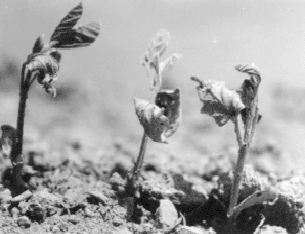
Figure
2.
Soybean seedlings wilting and drying in the field from Pythium,
root rot, caused by Pythium spp. (Courtesy H.J. Walters).
|
Symptoms
Pythium rot is caused by at least five species of the cosmopolitan
soilborne fungus Pythium. Species of Pythium generally
cause seedling diseases that may induce seed decay and damping-off
(seedlings fail to emerge or they emerge then wilt and collapse),
especially in wet seasons with high levels of rainfall before and
after planting. Pythium rot is most severe in poorly drained soils.
Infected plants have dark areas extending up the stem several inches
from the soil line. The diseased areas usually become translucent,
soft, and watery. These areas tear away when the plants are pulled
from the soil.
If dry weather sets in, the plants appear dry and shredded (Figure
2). Usually, the roots are badly decayed. Infected plants normally
occur singly or in small groups scattered throughout a field. Pythium
usually causes little reduction in yields. Infection by Pythium
species is often followed by infection by other root- and crown-rotting
microorganisms which can mask typical symptoms.
|
Disease Cycle
Pythium fungi are common inhabitants of the soil that colonize
crop residues and attack a wide range of crop plants. The fungi survive
in soil and plant residue as dormant, thick-walled oospores and as mycelium
in crop residues. When the soil is cool (50 to 59 F, 10 to 15 C) and wet,
the oospores commonly germinate and produce a sporangium in which zoospores
are formed. After escaping from the sporangium, the zoospores swim about
in the soil water and are attracted to seeds or to the roots of seedlings
where they encyst and later form a germ tube that penetrates and causes
infection. At higher temperatures (77 to 97 F, 25 to 36 C), the oospores
may germinate directly and form one or more germ tubes that penetrate
the seed coat or the root and stem tissues directly. Seedlings up to 10
days old are more susceptible to damping-off than older plants.
Control
- Plant high-quality, crack-free seed capable of at least 85% germination
in a warm or standard test and 70% in a cold test.
- Plant in warm soil (above 65 F, 18 C) that is well drained and
fertile and well prepared. Where feasible, turn under weeds or cover
crops several weeks before planting.
- Apply a seed or soil fungicide. For details, see the "Condensed
Plant Disease Management Guide for Field Crops", chapter in the
current Illinois Pest Control Manual. Fungicide seed protectants
will often increase emergence, especially when conditions do not favor
seedling growth and development. However, seed or soil fungicides will
not improve emergence of damaged or low-quality seed.
- Do not plant carryover seed or seed that has a high percentage
of cracked seed coats.
- Avoid excessive irrigation for the first 10 to 15 days after planting.
Back to Top
BROWN STEM ROT
|
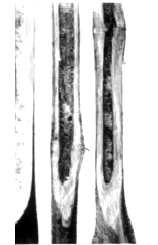
Figure
3a.
Brown stem rot.
|
Symptoms
Brown stem rot, caused by the fungus Phialophora gregata (synonym
Cephalosporium gregatum), enters plants through the roots
and lower stem. Losses are greatest when cool weather occurs during
the pod-filling stage (late July and first half of August) followed
by hot, dry weather. Losses of 17 to 25 percent may result from
lodging, premature death, or from the production of fewer and smaller
seeds.
Brown stem rot is difficult to recognize before pod set because
it has no external symptoms. When the stems of infected plants about
mid-season are split longitudinally, however, a characteristic,
dark reddish brown discoloration of the vascular elements and pith
is evident (Figure 3a), extending upward from the roots or crown.
Occasionally during hot, dry weather in late August or early September,
wilting occurs followed by a "scorching" (browning and
dying) of the leaf tissue between the veins. The leaves blight and
dry rapidly. Infected plants often look "frosted" (Figure
3b). The brown stem rot fungus reduces the efficiency of the water-conducting
tissues in the stem. However, leaf symptoms may vary and should
not be considered in diagnosis without splitting stems.
Disease development is optimum at air temperatures of 59 to 81
F (15 to 27 C). Little or no disease develops at temperatures above
90 F (32 C). Cool weather leads to more internal stem browning.
|
Disease Cycle
The brown stem rot fungus survives in soybean debris and in soil
to a depth of about one foot. The fungus produces spores on all
types of soybean residue except pods. Infection occurs through main
and lateral roots and the pathogen moves into the lower stem early
in the growing season. The fungus spreads slowly upward in the water-conducting
vessels. The pathogen may plug vessels partially or completely,
interfering with the flow of water and nutrients. The fungus has
been reported to be seedborne, surviving as mycelium within the
seed coat.
|
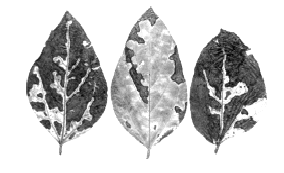
Figure
3b.
Brown stem rot.
|
Control
1. Grow soybeans in the same field only once in 3 or 4 years. Rotate
with corn, sorghum, small grains, forage grasses, legumes, or other crops.
2. Plant resistant cultivars in fields where brown rot is a severe
problem. Cultivars that mature early tend to escape severe infection,
but generally yield less than later-maturing ones in the absence of the
disease.
Back to Top
RHIZOCTONIA ROOT AND STEM ROT
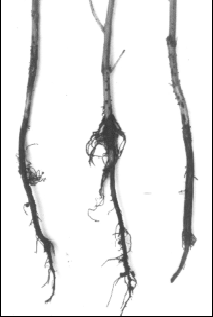
Figure
4.
Rhizoctonia root and stem rot.
|
Rhizoctonia root and stem rot is caused by the cosmopolitan, soilborne
fungus Rhizoctonia solani and is primarily a seedling disease
that attacks the basal stem and roots of young plants during May
and June causing pre-and postemergence damping-off. The disease
is found sometimes in conjunction with Pythium or Phytophthora rot.
Rhizoctonia infection typically produces a sunken, reddish brown
to dark brown decay of the outer layer of the main root and stem
at the soil line and below (Figure 4). In contrast with Pythium
root rot, Rhizoctonia-infected stems remain firm and dry. Phytophthora-infected
roots are a dull, dark brown; those infected with Rhizoctonia
are usually reddish brown. Rhizoctonia-diseased plants commonly
wilt in more or less circular patches 4 to 10 feet in diameter,
distributed irregularly throughout a field. Damping-off of seedlings
and stem and root decay can reduce stands and yield losses.
|
The Rhizoctonia fungus is a very common one which infects most
field crops, vegetables, ornamentals, and fruits. The fungus survives
in soil and plant residue as small, chestnut brown to black bodies (sclerotia)
or as resting mycelium. Many strains of the fungus can colonize essentially
any dead plant tissue. During moist soil conditions, sclerotia germinate
to form mycelium; or, the resting mycelium grows from all types of plant
debris to infect seeds, roots, and stem tissue.
The optimum temperature for disease development is between 77 and 85
F (25 and 29 C); but occasionally, severe losses may occur at 59 to 76
F (15 to 24 C). Rainfall followed by cool and then warm, humid weather
is most favorable for disease development. Growth of the Rhizoctonia
fungus in soil depends on nutrient supply; soil moisture, temperature
and pH; and competition from other soil microorganisms.
The severity of Rhizoctonia root and stem rot increases when plants are
grown in soils that are deficient in calcium, iron, magnesium, nitrogen,
phosphorus, sulfur, or any combination of these elements. There is evidence
that some herbicides reduce the number of microbial antagonists in the
soil, which favor Rhizoctonia solani.
1. The same as for Pythium Rot.
2. Ridge the soil around the base of plants during cultivation.
This practice often stimulates the production of new lateral roots above
the rotted basal portion of the taproot. Affected plants commonly recover,
at least partially.
3. Apply a recommended seed treatment. See the chapter, "Condensed
Plant Disease Management Guide for Field Crops", in the current Illinois
Pest Control Handbook for a list of seed protectant materials.
Back to Top
STEM CANKER
|
Stem canker is caused by the fungus Diaporthe phaseolorum
var. caulivora. It occurs throughout Illinois. Enlarging
cankers that are reddish brown to black, slightly sunken, and girdling
develop on the lower part of the stem, causing the plants to wilt,
wither, and die because the flow of water and nutrients to the foliage
is reduced or stopped completely. The lesions usually occur at the
fourth or fifth node (joint) or in the region of the second and
third trifoliolate leaves (Figure 5). Infected stems are brittle,
and the plants break over easily at the center. The symptoms of
stem canker usually appear in late July or early August, when the
pods are starting to fill out, and persist until the crop matures.
The plant withers and dies during the latter half of the growing
season. The dead, dried leaves remain attached, instead of dropping
off as they normally would at maturity.
An often overlooked symptom of stem canker is the appearance of
small, reddish brown lesions on one or both cotyledons. Infection
may spread into the stem, causing seedlings to wither and die. Seedlings
may also die before emergence. Yield losses of 20 to 50 percent
have been recorded when infection occurs soon after the pods begin
to develop.
|

Figure
5.
Stem canker
|
Disease Cycle
The stem-canker fungus overseasons in soybean residue in or on the soil,
and in infected seed. For the stem canker fungus, infected seeds may serve
as an important source of long range dissemination. The fungus survives
as mycelium and as clusters of long necked, black fruiting bodies (perithecia)
on infected tissue. The perithecia are capable of remaining viable up
to 14 months at temperatures of 4 to 65 F (-15 to 18 C). Perithecia, containing
large numbers of microscopic ascospores, are also produced in lesions
on infected cotyledons. The wind- and waterborne ascospores provide inoculum
for secondary infections. Most infections occur on the lower leaves. The
fungus grows from the leaf blade through the petiole to the stem, where
a typical canker results. A daily mean temperature of 70 F (21 C) during
wet weather is optimum for disease development.
Control
1. Plant high-quality, certified seed that is disease-free and will
germinate more than 80 to 85% in a warm germination test or over 70% in
a cold germination test.
2. Plant thoroughly cleaned seed in a warm, fertile, well-prepared
seedbed. Treat the seed with a protective fungicide. See the chapter "Condensed
Plant Disease Management Guide for Field Crops" in the current Illinois
Pest Control Handbook for details.
3. Bury infected crop residue after harvest, where soil erosion
is not a problem.
4. Where feasible, rotate soybeans for 1 or 2 years with corn, sorghum,
small grains, alfalfa, or forage legumes.
5. Make a foliar application of a labeled fungicide. This
is suggested for seed-production fields. For details, see the "Condensed
Plant Disease Management Guide for Field Crops" chapter. Spraying
increases seed size, quality, and germination. The proper and timely application
of a fungicide not only controls stem canker, but also pod and stem blight,
Septoria brown spot, anthracnose, Cercospora leaf spot or blight, target
spot, and purple seed stain. Yield increases are not unusual in Illinois
when August and September are very rainy and the harvest is delayed after
full maturity. If these conditions are not present, however, yield increases
may be minimal.
6. Harvest as soon as the crop is mature. When harvest is delayed
under wet conditions, seeds may be infected throughout the plant.
7. Maintain adequate potash based on a soil test.
Back to Top
POD AND STEM BLIGHT AND PHOMOPSIS SEED DECAY
Symptoms
Pod and stem blight, caused by Diaporthe phaseolorum var.
sojae (the asexual state is Phomopsis sojae), is similar
to stem canker but is spread more widely over the entire state of
Illinois. Another involved fungus is Phomopsis longicolla.
The relative presence of the two fungal species varies with location
and season. Pod and stem blight occurs primarily on plants nearing
maturity. Damage is most severe in wet seasons when harvest is delayed.
Seed infection is greater in densely populated fields, due to lodging
of plants.
Numerous, small black "pimples" (pycnidia, the fungus
fruiting bodies) appear on the stems and pods. These "pimples"
are first detected on petioles of abscised leaves. They are commonly
arranged in straight rows along the stem and are scattered on the
pods (Figure 6a). The causal fungus may produce seed rot as the
plants mature. Infected seeds (Figure 6b) are often discolored,
moldy, cracked, shriveled, lightweight, and often fail to germinate
when the soil is cool (59 to 68 F, 15 to 20 C) and wet. The infected
seeds that do germinate often give rise to infected seedlings, which
may serve as a source of inoculum. Pod and stem blight is a prime
factor in reducing seed quality in seed-production fields. Infected
seeds produce low quality oil and flour.
|
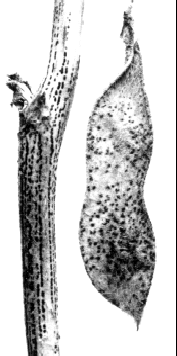
Figure
6a.
Pod and stem blight.
|
|
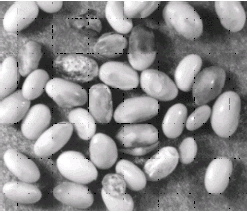
Figure
6b.
Soybean seeds infected with the pod and stem blight fungus, Diaporthe
phaseolorum vsr. Sojae (Phomopsis sojae).
|
Disease Cycle
The pod and stem blight fungus is seedborne. Most seed infection
occurs during or after the yellow pod stage (R7). Insect injury,
such as stinkbug feeding wounds on pods, may increase disease levels.
The fungus also overseasons in the residue of soybeans or other
host plants (e.g. cowpea, garlic, green bean, lespedeza, lima bean,
lupines, okra, onion, peanut, pepper, and tomato) as dormant mycelium.
Pycnidia of the Phomopsis state may be found in dead soybean
tissue such as Phytophthora - induced lesions, tissues damaged
by hail, or plants killed by other diseases. In wet seasons latent
infections produce tremendous members of pycnidia simultaneously
over entire plants as they mature.
|
Control - The same as for stem canker.
Back to Top
CHARCOAL ROT
|
Charcoal rot, summer, or dry weather wilt is caused by the widespread
soilborne fungus Macrophomina phaseolina (synonyms: Rhizoctonia
batiticola, Sclerotium batiticols). The disease attacks the
roots and basal portion of the plant throughout the season. Charcoal
rot is favored by hot, dry weather especially in combination with
fertility deficient soils or other unfavorable growing conditions.
Charcoal rot is usually found in plants of low vigor or in a weakened
condition after midseason, mostly in the southern two-thirds of
Illinois or other parts of the state. In an advanced stage, the
leaves on affected plants turn yellow, wilt, wither, but remain
attached. After flowering the lower stem and taproot may appear
light gray or silvery in color. When the outer "bark"
is peeled from the roots and stem base, small black specks can be
seen the microsclerotia (propagating bodies) of the causal fungus.
These specks may be so numerous that they give a grayish black color
to the tissues; hence, the name "charcoal rot" (Figure
7). When split open, the taproot and base of the stem show black
streaks in the woody portion. The causal fungus is a weak parasite
of soybeans that attacks and may kill seedlings and young plants
when their growth is retarded by hot, dry conditions.
Seedling infestations can mimic those of Rhizoctonia producing
a reddish superficial lesion on the hypocotyl. Charcoal rot lesions
do not cause a shrinking of tissues as does Rhizoctonia.
Lesions can often be scraped off with a fingernail where charcoal
rot is present.
|
|
|
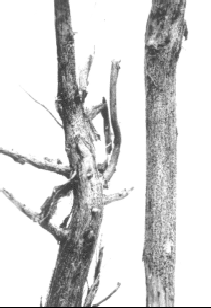
Figure
7.
Charcoal rot.
|
The charcoal rot fungus overseasons as jet black, round to oblong
or irregular microsclerotia and resting mycelium in dry soils and
embedded in plant residues. The sclerotia germinate on the surface
of roots. The resulting germ tubes penetrate and cause infection.
The fungus is also seedborne. The Macrophomina fungus restricts
water movement in the plant by mechanical plugging of the water-conducting
vessels with mycelium and microsclerotia and by secreting toxins
and enzymes that kill host tissues. Disease development and symptom
expression are most rapid at temperatures of 82 to 95 F (28 to 35
C).
|
1. Plant high-quality, certified seed that is disease-free. (Same
as No. 1 for Stem Canker.)
2. Plant soybeans at the recommended rate. Crowding of seedlings
makes them more subject to infection.
3. Fertilize, based on a soil test.
4. Rotate soybeans with non-host crops (cereals) for one or two years.
5. Where possible, irrigate during extended periods of hot, dry weather.
6. Plow down cleanly infected crop residue, where erosion is not
a problem. This places the sclerotia mostly into moist soil where
they are more subject to attack by other soil microorganisms.
Back to Top
SCLEROTINIA STEM ROT
|
Sclerotinia stem rot is caused by the soilborne fungus Sclerotinia
sclerotiorum. The disease is usually a minor one in Illinois,
except for local outbreaks (usually where snap beans, canola, or
sunflowers have recently been grown) during prolonged wet periods.
The disease is most common in areas of fields where air circulation
is poor, e.g. near woods. The first symptoms, often observed on
older plants, are the wilting and withering of the upper leaves.
A white, cottony growth appears on the branches, pods, and stems
of the soybeans, usually near the soil line and originating at stem
nodes. Large survival bodies (sclerotia) that are round to irregular
and eventually hard and black are formed on and inside the stem;
occasionally, in the pods (Figure 8). These sclerotia may be partly
covered with the dense cottony fungus growth. Plants die prematurely
when the stems are girdled by the fungus. The withered leaves remain
attached to the stem for some time. Pod development and pod fill
above the girdling stem lesions are greatly reduced. Soybean seedlings
may be killed before or after emergence from a watery, soft rot.
Seeds may become infected within diseased pods. Infected seeds are
discolored, flattened, and smaller than healthy seeds and sometimes
replaced by black sclerotia.
|
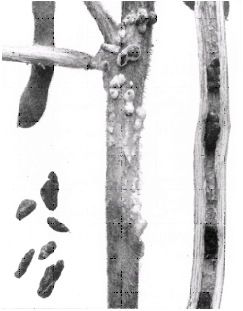
Figure
8.
Sclerotinia stem rot. Note sclerotia (lower left); also, those forming
on the stem (center) and inside the stem (right).
|
Sclerotia of the Sclerotinia fungus can survive in the soil for long
periods and are highly resistant to most fungicides. The sclerotia germinate
within 2 inches (5 cm) of the soil surface by producing one to many light
tan to brown, funnel-shaped structures (apothecia) during prolonged periods
of cool (40 to 59 F, 5 to 15 C), wet weather. Large numbers of asci are
formed in the apothecia, which literally eject "clouds" of ascospores
under proper conditions. The windborne ascospores germinate and infect
soybean blossoms, stems, branches, and pods under very damp conditions.
1. Do not rotate soybeans with garden, snap beans (Phaseolus spp),
canola or sunflowers. Control broadleaf weeds which may serve as hosts.
2. Thoroughly clean contaminated seed lots to screen out some of
the sclerotia. At a foreign port of entry, even a few sclerotia in
a shipment intended for human consumption are grounds for rejection.
3. Grow soybean cultivars that do not lodge readily.
4. Avoid planting soybeans in narrow rows (less than 30 inches
or 76 cm) in fields with a history of Sclerotinia stem rot.
5. Avoid irrigation at flowering. High humidity in the canopy
at this time increases disease levels.
Back to Top
SUDDEN DEATH SYNDROME
|

Figure
9.
Sudden death syndrome. A. early symptoms showing small yellow blotching;
B. late symptoms, note distinctive green vein pattern; C. defoliation
(courtesy S.B. Belmar)
|
Sudden death syndrome (SDS), caused by a strain of the soilborne
fungus Fusarium solani, generally appears about midsummer
in soybeans with high yield potential usually after blooming. The
disease can result in minor or severe yield loss, depending on when
it develops. SDS is identified by the appearance of small, scattered
yellow spots or blotches usually on the upper leaves (Figure 9a).
These spots enlarge, merge, and the tissues turn brown between the
veins; however, the veinal tissues remain green (Figure 9b). Leaflets
may curl upward or drop prematurely, leaving the petioles firmly
attached (Figure 9c). Severe foliar symptoms give affected areas
in a field a tan to brown cast and may be the first evidence of
the disease. Flowers and pods may abort and pods drop or not fill.
The first pods to set may have a few beans in them which remain
small. Later pods may not fill or may have immature green seed.
One characteristic of SDS is that the interior of the stem (pith
region) remains white. There may be a slight gray-brown discoloration
of the vascular system just inside the outer "bark" of
the stem but the pith remains white. If the pith is discolored,
it may indicate the presence of brown stem rot. Root symptoms preclude
foliar symptoms and result in deterioration of the topmost, lateral
roots, and nitrogen-fixing nodules. Fields in which the disease
is present are likely to develop SDS in subsequent years, although
there are no accurate methods of assessing possible disease levels.
|
The Fusarium fungus overseasons as thick-walled chlamydospores
or mycelium in crop debris or in soil. SDS is affected by weather conditions.
The disease is more severe during cool, wet growing seasons. It is commonly
found in association with soybean cyst nematodes (SCN) and in lower areas
of fields. Nematodes are believed to act as a stress factor rather than
being directly involved with the disease. However, work in Mississippi
has shown that SCN can act to spread the fungus. This research demonstrated
that the Fusarium fungus was present both on and in the cysts of
soybean cyst nematode. Therefore, direct or indirect movement of the nematode
could spread the fungus to new areas. The disease tends to be most severe
on well managed soybeans with a high yield potential. However, tillage
and rotation practices seem to have little impact on this disease.
|



